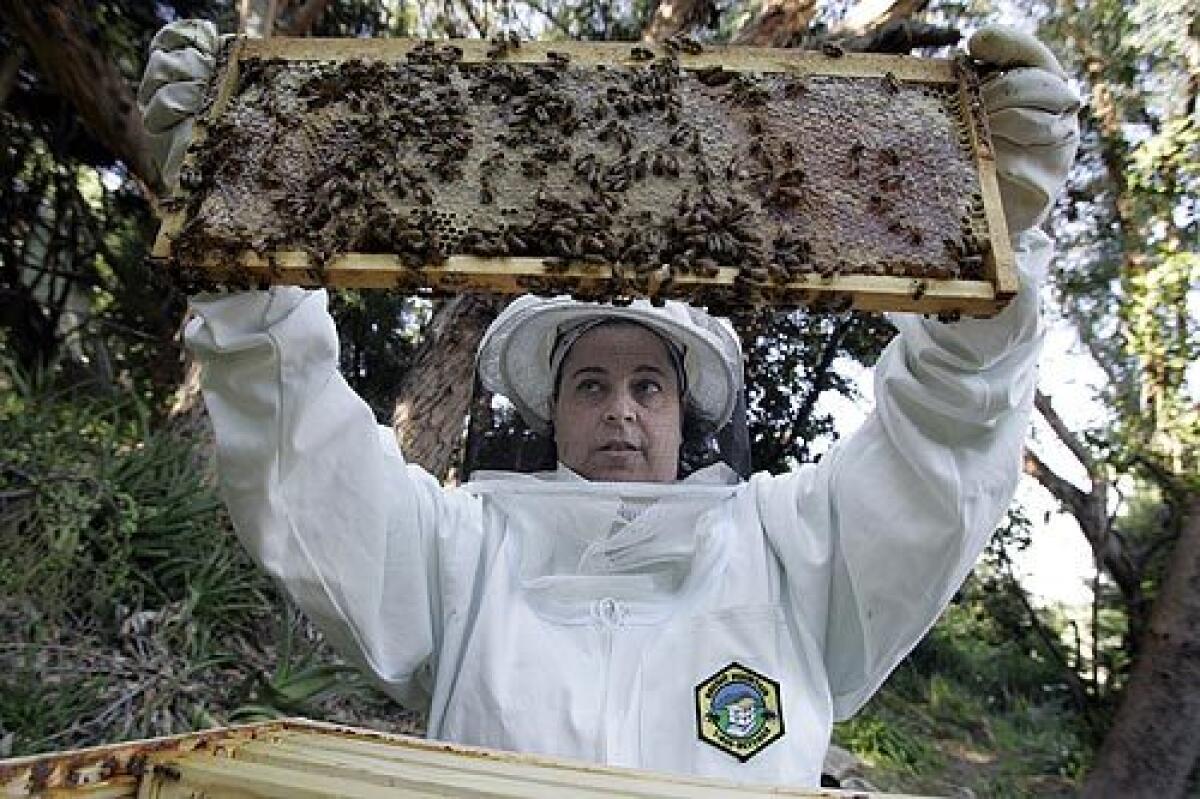Urban beekeepers know it’s more than just honey and money

Kirk Anderson bought his first honeybees from a Montgomery Ward catalog in 1970.
The 3-pound cage came in the mail, and as he opened it and fed the bees sugar water, his lifelong passion with Apis mellifera began.
Nearly 40 years later, Anderson, 61, calls himself an urban beekeeper, and he cares passionately enough about bees that he does house-call rescues throughout Los Angeles County.
Anderson gets 20 calls a week. He fishes the insects out of Jacuzzis, removes them from chimneys and shakes them from trees.
His efforts come amid a growing interest in beekeeping in urban areas, as word of the mysterious collapse of bee colonies has spread.
Honeybee colonies pollinate a third of the nation’s food supply and are crucial to California’s agriculture industry. Hives from around the country are brought in each year to pollinate almond trees and other crops. Central Valley farmers have struggled in the last three years as the cost of renting hives rises and the number of bees nationwide dwindles.
On a hot afternoon in a dusty hillside yard in Silver Lake, Anderson dons a netted hood and white jumpsuit, pulls on big yellow gloves and then places a box next to a dried-out pear tree. He shakes the trunk, and, like a maestro conducting a choir, uses a wooden stick to lead the bees into their new abode.
“They want to have a home. That’s their purpose. I’m just providing it for them,” Anderson said.
Once the bees are captured, Anderson “re-purposes” them, selling them to beekeeping club members who pay $75 for a box of the insects and some instruction.
The Backwards Beekeepers formed their club last year, taking their name from writer-beekeeper Charles Martin Simon’s philosophy of “beekeeping backwards” -- working with nature and not thinking that keeping is just about money and honey.
Anderson, who likes to jest that “backwards is the new forward,” waxes rhapsodic about the revival of a lost art. “We’re resurrecting beekeeping as a profession,” he said. “You don’t see people talking to kids at a job fair about beekeeping, do you?”
A house painter by trade, Anderson hopes to be able to make enough money from beekeeping to call it his full-time work.
Scientists nationwide are struggling with the mystery of “colony collapse disorder” (CCD); for Anderson, the answers are simple.
“It is obvious that bees are dying from being fed unnatural substances and being exposed to pesticides,” he said. “I think everything commercial beekeepers are doing to the bees predisposes them to whatever they got going on. If you’re moving them around and feeding them chemicals, to me it is not a mystery.”
Anderson’s backyard biology is not far from the mark. Scientists are focusing on mites, diseases, pesticides, global warming and overworked commercial colonies, among other factors.
“We’re starting to see how the pieces fit together instead of examining them individually,” said Dr. Dewey Caron of the Mid-Atlantic Apiculture Research and Extension Consortium.
“When you are exposed to a lot of somethings, together, finally it is the proverbial last straw,” Caron said.
Russell Bates and Amy Seidenwurm, a married couple living in Silver Lake, are new keepers. Their five-box hive sits on the third tier of their lush garden of lemon trees and purple flowers.
They began last September, and since then they’ve grown attached.
“At first, we thought: ‘We’re gonna get honey! We’re gonna get honey!’ ” Bates said. But now the couple are excited about the bees themselves.
“We have a lot of affection for our bees. They’re like our 50,000 pets,” Seidenwurm said.
Bates explained that beekeeping in the city not only provides a pesticide-free environment for bees, but allows residents to delve deeper into organic living.
“There’s a lot of uncertainty about bees,” he said. “And people are freaking out about the economy. So because of that, people are thinking about their home environment a lot more. Beekeeping fits right into that because it doesn’t require a lot of money or outside investment. It’s way less work than having a cat or a dog.”
Anderson, Bates, Seidenwurm and the Backwards Beekeepers are not alone.
Keepers from Orange County to the San Fernando Valley gather in recreation rooms, hillside homes and community gardens. The Beekeepers Assn. of Southern California is 100 members strong. Beekeepers -- backyard and/or commercial -- cite media coverage of colony collapse disorder as the reason for burgeoning interest in local beekeeping.
Will this surge in urban beekeeping beat back CCD or save California’s food supply? Hardly, said Chris Heinz, bee task force liaison for the Almond Board of California.
“It’s a good thing, but L.A. beekeepers aren’t going to help commercial beekeeping in the Central Valley,” she said. “Hopefully, it is good for genetic diversity, but it won’t make a significant dent in agriculture pollination.”
While commercial beekeepers struggle to stay in business and bees strive to stay alive, Anderson and his counterparts continue to preserve the local honeybee population, one insect at a time.
More to Read
Sign up for Essential California
The most important California stories and recommendations in your inbox every morning.
You may occasionally receive promotional content from the Los Angeles Times.










